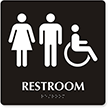23 years after the ADA, Amtrak stations still inaccessible
The National Disability Rights Network reveals that several of the country’s Amtrak stations remain inaccessible for people with disabilities. A report published by the network on the 23rd anniversary of the Americans with Disabilities Act (ADA) discloses Amtrak’s inefficiencies.
The ADA advocates and allied groups, who visited Amtrak stations in July and August this year, found that the stations lacked ramps or elevators. The ticket counters were too high, accessible parking was improperly marked, and the restroom entrances were too narrow for people using wheelchairs.
Of the 94 stations visited across 25 states, 89 stations had accessibility problems. Among these stations was Amtrak’s second busiest station, Union Station in Washington, D.C., which — though it fared better than most — lacked an elevator on a platform serving southbound trains.
Report says progress on accessibility too slow; Amtrak agrees
Despite a 20-year compliance extension granted by Congress and the Department of Transportation and Justice to make its stations accessible (the longest extension provided to any public service till date), Amtrak has failed to fulfill even the basic ADA requirements. Contributors to the report remark, “Does it really require that long to install a ramp to a station entrance so that a person using a wheelchair can actually get into the station?”
In a company newsletter, Amtrak details the steps the company has undertaken for passengers with disabilities — repairs and upgrades to platforms, ramps, sidewalks, and renovated entrances and restrooms. However, officials maintain that the pace of progress is indeed slow.
Amtrak President and CEO Joe Boardman says, “Passengers with disabilities represent a large and growing share of Amtrak ridership and we are proud of our role as an important means of transportation providing for independent and dignified travel…However, we are not satisfied with our pace of progress on accessibility issues at the stations we serve.”
Amtrak does not have full control over many stations and owns only 14 percent of the 500 stations that must be ADA compliant. It blames this lack of control for its failure in making services inaccessible. However, advocacy groups say it had enough time to coordinate with multiple owners and was given 20 years for this precise reason.

Union station in Washington, D.C. From shankar s.
Current provisions for Amtrak passengers
Amtrak has accessible seating and restrooms. Its long distance trains feature accessible bedrooms. The company also provides discounts for passengers with disabilities and their attendants.
Passengers can request for assistance at the station when making a reservation. However, passengers are required to arrive one hour prior to the train departure to get enough time for this service.
In the absence of an elevator on a platform, passengers with disabilities “must wait for carts operated by Amtrak personnel that take a circuitous route out along uncovered portions of the platforms and crossing tracks to get to and from the station,” reports the Washington Post.
The Indiana Protection and Advocacy Services Commission (IPAS), an organization protecting the rights of individuals with disabilities, has filed a disability discrimination complaint with the United States Department of Justice (USDJ). “People with disabilities have been very patient with Amtrak and IPAS believes that enough is enough; 23 years is a long time for individuals with disabilities to wait for equal access,” says Gary Richter, executive director of IPAS.
Amtrak is now working with owners to address accessibility issues in its stations.
Category: ADA





